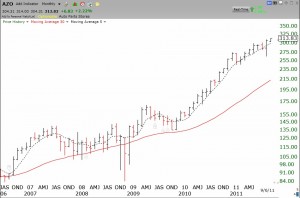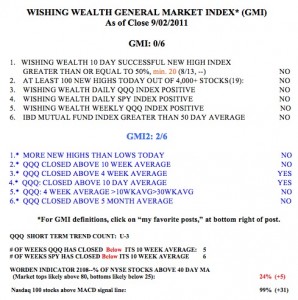With the latest poll showing almost as many bears as bulls, the market looks set to rally. It is rare for there to be so many bears. The T2108, at 31%, is also in neutral territory. This bottom may be solid. Nevertheless, I will still wait for higher GMI readings before I wade into this market.
New QQQ short term down-trend; mainly in cash, and one AZO call
The QQQ began a new short term down-trend on Tuesday. Nevertheless, note that bearish adviser sentiment is only 4 percentage points below bullish sentiment. This is a contrary indicator and suggests that much of the selling may be over. It is rare that bearish sentiment gets close to or above bullish sentiment. The T2108, while low at 22%, is far above the 7% seen at the lows on August 8. If the August lows hold, we could see a major rally develop. I remain almost 100% in cash until a longer term up-trend develops with the GMI around at least 4.
Continuing my search for new leaders, note that two auto parts stocks, AZO and ORLY, showed up on the new 52 week high list on Tuesday. I could not resist buying a Sept 300 call option on AZO, in my most speculative trading account. Having a stock at a new high after all of the market weakness is a terrific sign of technical strength and AZO could rise if the market rebounds. AZO is one of the nine high priced leaders I follow regularly. Below is a monthly chart of this growth stock (click on to enlarge).
Futures portend down open; new QQQ short term up-trend in jeopardy; still in cash
I have been saying for quite some time that we needed to wait until the counter-trend rally was complete in order to see if the recent bottom will hold. If the bottom holds, we could see the rally resume. Still, the market remains in a longer term down-trend for now and it makes the most sense to me to stay in cash until the trend turns up. The new QQQ short term up-trend could end with a decline on Tuesday. With the GMI at zero, it makes no sense to have any long positions.
I love to watch the new high list for clues to the next leaders when the market recovers. Most stocks hitting new highs are gold-related. However, several other strong stocks that I am watching are: MAKO, JAZZ, COG, CF and ALXN. I will watch them patiently until the market trend turns up and the GMI approaches 4.

